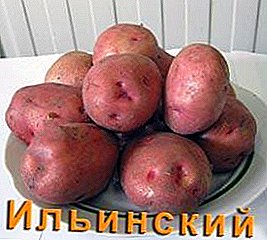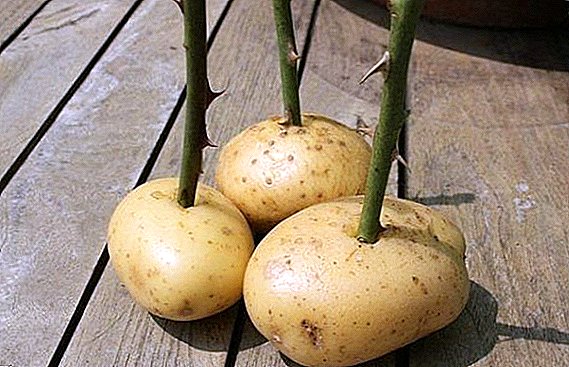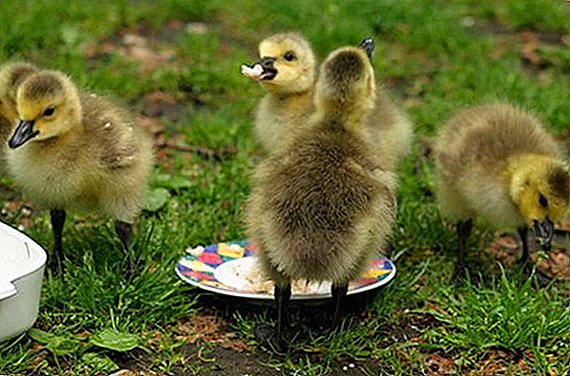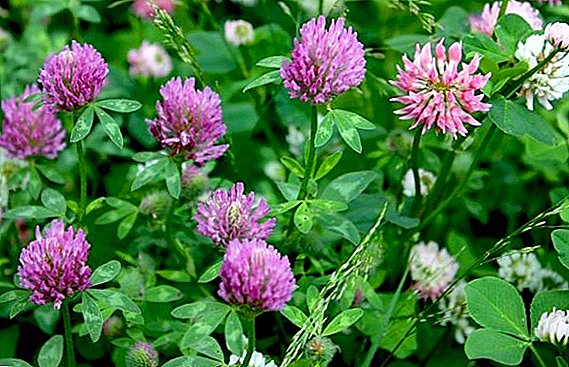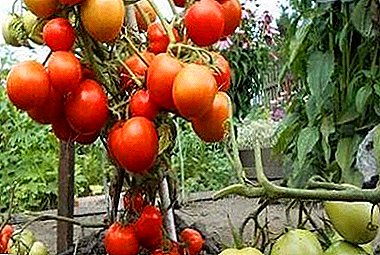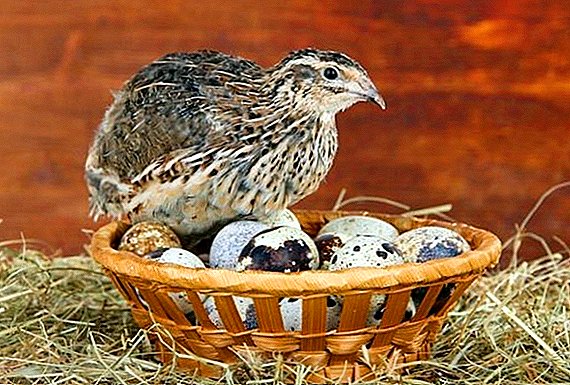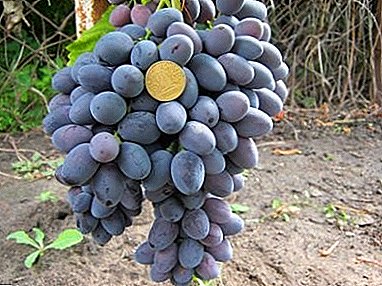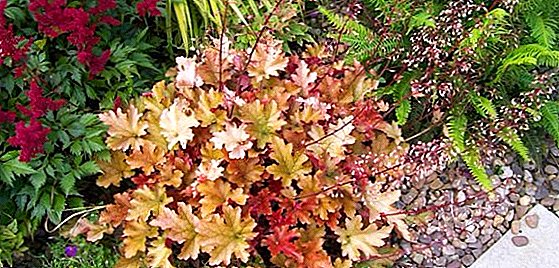 To give originality to flowerbeds, sometimes a plant with large leaves of various colors and shades is used - this is a geyhera, which, due to this, received wide distribution in landscape design. The plant came to us from North America and, thanks to the efforts of breeders, received a more exotic bright color and successful settlement in our flowerbeds.
To give originality to flowerbeds, sometimes a plant with large leaves of various colors and shades is used - this is a geyhera, which, due to this, received wide distribution in landscape design. The plant came to us from North America and, thanks to the efforts of breeders, received a more exotic bright color and successful settlement in our flowerbeds.
Popular plant varieties
All modern varieties of geykher obtained from the main types:
- Gaikhera fibrous (H. villosa) - a plant with gorgeous velvet leaves and inconspicuous green and cream flowers.
- American geyhera (H. americana) is a forest species with attractive leaves up to 20 cm in height. The leaf color is brown-purple, has a rounded heart-shaped form with long petioles. American geyher blooms in June with yellow-green flowers.
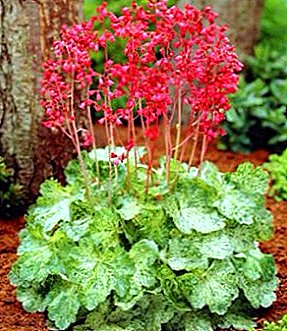 Geicher blood-red (H. sanguinea) - a plant with dense foliage of green color. The shape of the leaves is round dentate. Flowers in the form of red bells on peduncles up to 50 cm. The plant blooms from June to August.
Geicher blood-red (H. sanguinea) - a plant with dense foliage of green color. The shape of the leaves is round dentate. Flowers in the form of red bells on peduncles up to 50 cm. The plant blooms from June to August.- Cylindrical geichera (H. cylindrica) - a plant with a green rounded heart-shaped foliage. Differs in large cylindrical inflorescences. Flowers can be green, beige or coral.
- Geichera small-colored (H. micrantha) - the plant has leaves with gray-silver spots, in form similar to a maple leaf. The flowers are small with cream-pink flowers, placed on peduncles up to 60 cm high. It blooms from late May to late July.
Did you know? The full collection of geykher varieties has more than 400 copies and is increased annually by several dozen.With the help of crossbreeding, breeders brought out more vibrant hybrid varieties of geyher:
- With foliage of red color ("Purple Palace", "Black Bird", "Cherry Cola");
- With yellow foliage ("Marmelade", "Key Lime Pie", "Citronelle");
- With silver foliage ("Mint Frost", "Stormy Seas", "Can Can", "Regina");
- With spotted foliage ("Midnight Rose", "Color Dream", "Hercules");
- With gorgeous flowers of red, white or lingonberry color ("Alba", "Bressingham Hybrids", "Robusta", "Snowstorm", "Splendens", "Splish-Splash").
How to create conditions in your garden for geyhery
 Growing geyhery in the garden is not a time consuming process. The plant will please you if you carry out the correct planting and minimum care for geyhery. When planting it, do not worry about the neighboring plants on the site. Geykhera perfectly coexists with daylilies, primroses and decorative cereals. The young leaves of the plant are translucent. But over time, they thicken and darken. If the lower leaves are fallen, and the stem is bare, it is necessary to deepen the plant with the earthy clod before flowering. Trimming the peduncles after flowering, you will give the plant a more aesthetic look. By following the simple tips, you will achieve that your plant looks great in a flower bed and in the garden.
Growing geyhery in the garden is not a time consuming process. The plant will please you if you carry out the correct planting and minimum care for geyhery. When planting it, do not worry about the neighboring plants on the site. Geykhera perfectly coexists with daylilies, primroses and decorative cereals. The young leaves of the plant are translucent. But over time, they thicken and darken. If the lower leaves are fallen, and the stem is bare, it is necessary to deepen the plant with the earthy clod before flowering. Trimming the peduncles after flowering, you will give the plant a more aesthetic look. By following the simple tips, you will achieve that your plant looks great in a flower bed and in the garden.
Did you know? Geicher used Indians as a medicinal plant for fever and diarrhea and as a wound healing agent.
Requirements for lighting and soil
Geykhera feels great both in the sun in the penumbra of other plants, and under a small tree in the shade, therefore the best place for her is the east or west side.  But one should also take into account the specific features of the plant: brightly colored leaves need higher illumination, this will give them a brighter color. For example, a plant with red leaves in the shade turns green.
But one should also take into account the specific features of the plant: brightly colored leaves need higher illumination, this will give them a brighter color. For example, a plant with red leaves in the shade turns green.
Geicher is not demanding on the choice of soil. But if you want to have a beautiful plant on your plot, then you need to take into account several factors: first, Geyhera does not tolerate acidified soil. The optimum pH for it should be 5-6 units. Secondly, the plant does not tolerate stagnant water in the roots. Therefore, planting geyheru, take care of good drainage. All other difficulties the plant tolerates easily.
Did you know? The most capricious are yellow, red and light-green geyher.
Watering and feeding the soil
Watering the plants should be moderate, in a hot time - once a week, although the geykher withstands a short dry period well. To prevent rotting of the roots, it is necessary to sprinkle the roots with soil mixed with fine expanded clay, sand or perlite.
Since the plant in its homeland grows on stony ground, and it is not very fertile, it is necessary to make fertilizer moderately. Use universal fertilizers for decorative-flowering or decorative leafy plants, according to the type of plant. The dose of fertilizer should be halved from the recommended in the instructions.
Preparing the plant for winter
 The faded and yellowed leaves of geyher envelop the roots of the plant and help to survive the winter. The wintering of the geykher is better with additional shelter for the winter with the help of fallen leaves. And in the spring, after removing the shelter, it is necessary to cut the last-year leaves of the plant with shears.
The faded and yellowed leaves of geyher envelop the roots of the plant and help to survive the winter. The wintering of the geykher is better with additional shelter for the winter with the help of fallen leaves. And in the spring, after removing the shelter, it is necessary to cut the last-year leaves of the plant with shears.
Important! In no case do not cut the leaves of geyhery for the winter.
Geykher transplant
The question arises, when is it better to replant the geyher - in spring or autumn? Repotting plants should be carried out in March or April.
Ornamental plants remain up to five years, in the future the plant needs to be transplanted. For this you need:
- Dig up a bush of a plant and remove dry leaves.
- If you do not plan to seat, then after removing rotten and dry roots with a sharp knife, reduce the root portion to at least 3 outlets. Sections can be sprinkled with charcoal or cinnamon.
- In the hole when planting we add a little ash to neutralize the acidity in the soil, and the soil can be shifted with sand or perlite.
- Planted so as not to sprinkle the central kidney, and water the plant.

Important! Even the most beautiful geyher lose their decorative effect over time, therefore they need rejuvenation.
Breeding methods
Consider the methods of reproduction geyhery, their advantages and disadvantages.
Seeds
 Propagation of geyher seeds must be used to create a large amount of planting material. Seeds are used only fresh, it will significantly increase their germination. Growing seedlings carried out in containers in the greenhouse or on the windowsill. Sowing of seeds is superficial, carried out in the soil with the addition of perlite or vermiculite. Shoots should be expected in 2-4 weeks. After the appearance of 2-3 leaves, you must dive into separate pots.
Propagation of geyher seeds must be used to create a large amount of planting material. Seeds are used only fresh, it will significantly increase their germination. Growing seedlings carried out in containers in the greenhouse or on the windowsill. Sowing of seeds is superficial, carried out in the soil with the addition of perlite or vermiculite. Shoots should be expected in 2-4 weeks. After the appearance of 2-3 leaves, you must dive into separate pots.
Since most varieties of geyher are hybrids, growing geyher from seed at home will lead to the emergence of plants, in most cases not similar to the mother plant. Only some of them will contain maternal symptoms.
Dividing bush
 This breeding method is best done in early May or in August. To do this, you must have an adult (3-4 years) bush plants. Geyheru dig, washed the roots, using a sharp knife divided into 3-4 parts. Each part should have 2-3 sockets. Sections are disinfected with charcoal or cinnamon. Before planting, the number of leaves is reduced, it will prevent moisture loss. Planting plants carried out similarly as when transplanting geyhery. It is possible to water a plant with Kornevin, it stimulates the growth of the root system. As a rule, geykher tolerates the division of the bush, and as a result you will get several plants with fully preserved maternal signs.
This breeding method is best done in early May or in August. To do this, you must have an adult (3-4 years) bush plants. Geyheru dig, washed the roots, using a sharp knife divided into 3-4 parts. Each part should have 2-3 sockets. Sections are disinfected with charcoal or cinnamon. Before planting, the number of leaves is reduced, it will prevent moisture loss. Planting plants carried out similarly as when transplanting geyhery. It is possible to water a plant with Kornevin, it stimulates the growth of the root system. As a rule, geykher tolerates the division of the bush, and as a result you will get several plants with fully preserved maternal signs.
Cuttings
 This method is used in May - June, before the flowering of the plant. To do this, cut off the outlet without the root from the main bush and plant it in a special mini-greenhouse - under a jar or canister into the ground with the addition of perlite or peat and sand. Shading in this case is carried out necessarily. Very important is the care of the plant: pruning leaves to reduce evaporation, watering means for rooting plants. The successful rooting is indicated by the appearance of young leaves. This can happen in 3-4 weeks.
This method is used in May - June, before the flowering of the plant. To do this, cut off the outlet without the root from the main bush and plant it in a special mini-greenhouse - under a jar or canister into the ground with the addition of perlite or peat and sand. Shading in this case is carried out necessarily. Very important is the care of the plant: pruning leaves to reduce evaporation, watering means for rooting plants. The successful rooting is indicated by the appearance of young leaves. This can happen in 3-4 weeks.
The use of geykhery in landscape design
In landscape design geykheru used for curb disembarkation or in the design of ponds on stones. Due to the bright color of the foliage, geyher is often placed as an accent plant against a green background to create beautiful compositions with geyher in the garden. This plant is compact and well friends with other, not even large plants. Now the work of breeders is focused on increasing the geyher flowers, a bouquet of which will delight you throughout the month. Often the plant is used to hide problem areas of the garden. It is lush and can fill the void in the periods between the flowering of other plants. Due to its unpretentious geyhera becoming more common.

The main pests of geykhery, ways to combat them
Geicher does not belong to capricious plants, so rarely it hurts. But improper plant care can damage the foliage with powdery mildew, rust, gray rot and spotting. To prevent these diseases, it is necessary to fertilize according to the instructions and make sure that the roots do not stagnate water. In case of illness, the plants must be treated with chemicals.
If the leaves of the plant are covered with a whitish bloom - it is powdery mildew, and treatment with a fungicide will help in this case. If black or red spots appear on the leaves, it is spotting or rust. Treat the plant twice a month with a solution of Bordeaux liquid, and you will save it from the disease.
In the case of rotting of the roots, it is necessary to cut off the socket to a healthy tissue and transplant the plant into the ground with the addition of perlite or peat and sand. It is necessary to fight pests with the help of insecticides. Sometimes snails, weevils, caterpillars, slugs, leaf nematodes eat the leaves of the plant and spoil its decorative qualities.


 Geicher blood-red (H. sanguinea) - a plant with dense foliage of green color. The shape of the leaves is round dentate. Flowers in the form of red bells on peduncles up to 50 cm. The plant blooms from June to August.
Geicher blood-red (H. sanguinea) - a plant with dense foliage of green color. The shape of the leaves is round dentate. Flowers in the form of red bells on peduncles up to 50 cm. The plant blooms from June to August.
